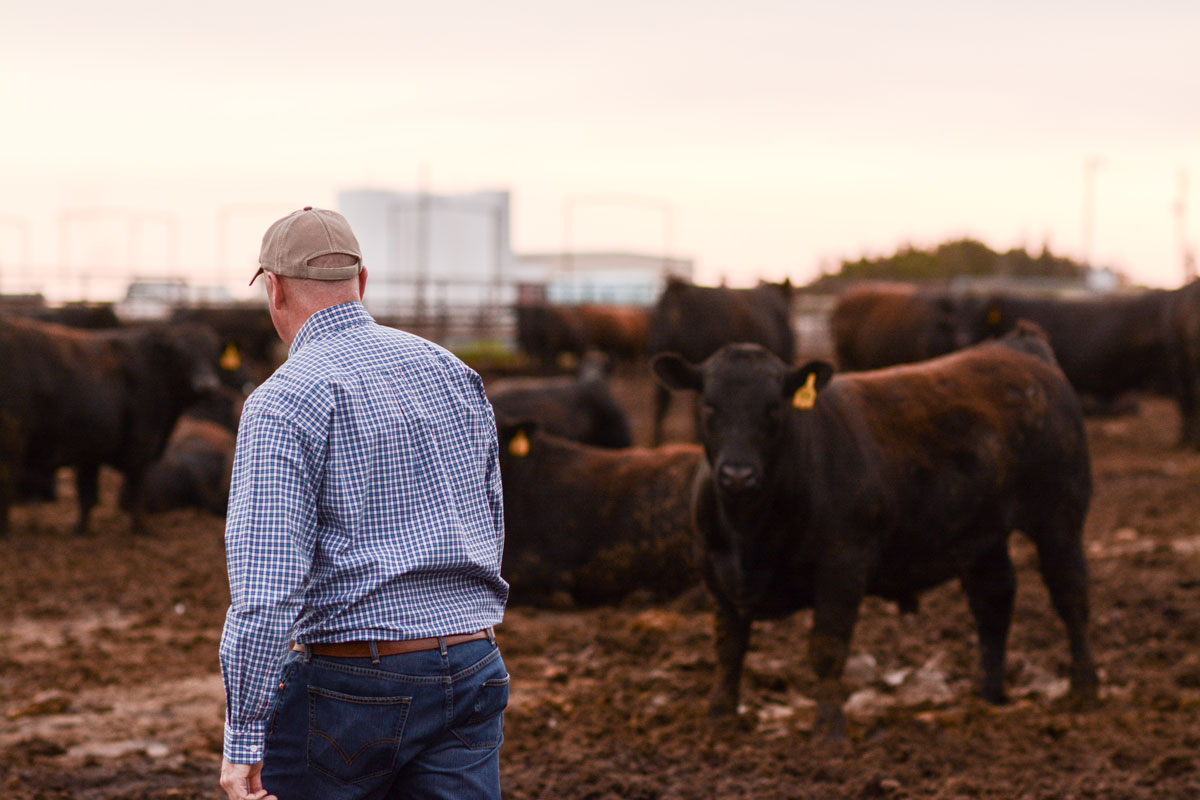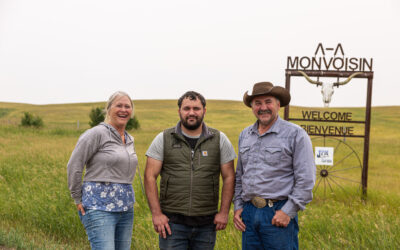
Matching the yard
Find the right fit for your cattle, goals
by Abbie Burnett
July 6, 2021
Choosing a feedyard is a bit like selecting a life partner: success comes from clear communication and shared goals.
“It’s maybe not as serious as picking a spouse, but probably not too far away either,” says Warren Rusche.
The South Dakota State Extension feedlot specialist says it all starts with a conversation.
“Not every ranch is alike, not every pen of cattle is alike, and not every feedlot is ideally suited to handle the same class of cattle,” Rusche says.
Understand the options
Feedyards offer different marketing opportunities and strategies. A manager should be able to look at a customer’s pen and know, “I have a good market for those cattle. I can handle it.”
That’s according to David Trowbridge, longtime manager of Gregory Feedlot, Tabor, Iowa.
For Angus genetics, Rusche suggests a yard with grid marketing experience. A cow-calf operator could sell outright, retain ownership or partner with the feedyard, the choice often depending on financing options. Gregory Feedlot offers cattle and feed financing, hedging and risk management.
“It can be an attractive option for cash flow or the ability to forego income for a few months,” Rusche says.
Just what a yard offers may be linked to the number of cattle to be fed, he says. Having enough to fill a semi-trailer load and pen may provide more options; fewer cattle may require commingling with other producers to fill a pen.
“If you have a sizeable ranch where a portion of the calf crop is sold right off weaning and another portion is going to get backgrounded or leave the ranch at another point, and another is open replacement heifers, sending those groups of cattle to different yards might make sense,” Rusche says.
Make sure the yard can handle your specific needs. Can it manage bawling calves? Unvaccinated heifers? Preconditioned feeders?
Outline the objectives
Trowbridge says customers and feedyards should align their ideals. “We’re providing a product that our customers have to use,” he explains. “Ultimately, the customer has to make money for the feedlot to continue to make money.”
A realistic conversation about cost of gain is paramount.
“The feedlot manager can’t guarantee it, but should be able to give you some estimates or expectations on feed costs, what their history says and what your cattle should convert at,” Rusche says.
If data collection is important, the yard should be prepared to make it available.
“There are cattle feeders that do a great job, but collecting data is not part of what they do,” Trowbridge says. “It wouldn’t be a great partnership if that’s what you want.”

Some rancher-feeder relationships begin when the latter buys a set of calves.
There’s opportunity for commercial producers using Angus genetics and offering extra information through programs like AngusLink™, Rusche says. Providing key information about the source of genetics, health protocols and veterinary receipts can add value.
“That may attract an extra bid or two and have a few more people looking at them versus well, here’s another set of black-hided calves,” he says.
Ask about risk, Trowbridge advises.
“You need someone that’s going to give you an honest assessment of what the situation is. I don’t always recommend that a producer finish cattle,” he says. “Sometimes I recommend they go ahead and sell them as feeder cattle, or grow them in a grow yard and get them to 800 or 900 pounds and then sell them. But you have to look at what your options are, what your risk adversity is and make a decision.”
When feedyard shopping, remember these principles:
- Cost is important, but so is cost of gain. “Make sure you’re comparing ultimate bottom line, not just some of the components that go into it,” Rusche says.
- Avoid greener grass. If you’re happy with your feedyard, avoid the temptation to go elsewhere. “It’s about the relationship, having that personal touch where the manager calls you when there’s a problem or when there’s success,” Trowbridge says.
- Get it in writing. “Even if we never have to pull that piece of paper out again, the fact that it’s written down helps people remember exactly what we agree to and know what the expectations are,” Rusche says.
- Don’t be stingy with information. A successful feedlot accurately assesses and values risk. “The more questions the rancher can answer, the less risk those calves present and the more valuable they become,” Rusche says. Opportunity cattle – those with unknown genetics and health – are attractive only when they’re cheap. “No rancher I know has a goal to sell cheap calves,” he adds.
The human element
When visiting a yard in person, take note of overall appearance and how it’s maintained. Is there feed outside the bunks? How do personnel act around the cattle?
“Most feedlots are well–run, well–managed places that look pretty good,” Trowbridge says, “but you can run into places where you see spilled feed, fences that aren’t fixed, pens not maintained. Overall appearance of the feedlot is probably most important.”
Meet the management team and learn their business philosophy.
“You don’t really feed cattle with Gregory Feedlots, you feed cattle with David Trowbridge,” Trowbridge says. “You need to form a personal relationship with that person because you’re entrusting that person with, in a lot of cases, most of your cattle income for the year.”
Rusche suggests getting references from a feedyard’s nutritionist and veterinarian, plus current and former customers.
“It’s no different than interviewing someone for a position on the ranch,” he says. “Any kind of background information you can gather is valuable. The really good, professional yards aren’t going to be afraid of you knowing who their customers are that are happy.”
Continue those conversations every year.
“If I can find the right partner, I want to stick with that one person as much as I can to really build that relationship,” Rusche says. “When people are looking at seedstock providers, a lot of people use one or just a couple because it’s become a business relationship and information flow, and this should work the same way.”

When to begin
Do the homework ahead of marketing season (early summer for spring-born calves), make phone calls to narrow the list and follow up with yards that fit the bill. Don’t wait until just before the sale to make contact with buyers, Rusche and Trowbridge agree.
If calves are consigned to a specific sale, indicate the date, location and auction company. If choosing to sell direct or partner in a private-treaty transaction, share the timeline to solidify an agreement with a buyer. A week or two prior to the sale date, remind the interested buyers of the auction date or begin talking about a private-treaty agreement.
Talk with the feedyard well in advance about available spots and when the calves are ready.
The bottom line
Rusche emphasizes shared values.
“Do they have the facilities, management, skills and labor to manage health risks and get cattle to convert as efficiently and cheaply as possible and then deliver a product that is going to have as much value as it can in the marketplace?”
Trowbridge agrees. “It’s about finding someone you can communicate with, who understands your objectives and business plan and is willing to work with you to make it successful.”
Originally published in the Angus Beef Bulletin.
You may also like
Kansas Ranchers Recognized for Sustainability Efforts
Kansas’ Wharton 3C Ranch thrives despite droughts, winning the CAB 2023 Sustainability award. The data-driven, quality-focused approach of first-generation ranchers, Shannon and Rusty Wharton, yields 100% CAB cattle. Their commitment to sustainability and industry collaboration sets a bright future for the cattle business.
Saskatchewan Angus Ranch Earns Certified Angus Beef Award
JPM Farms in Canada quietly gained recognition for its dedication to environmental sustainability and quality cattle. The Monvoisin family earned the 2023 CAB Canadian Commitment to Excellence award for their outstanding results and partnership with Duck Unlimited, showcasing their commitment to improving the land, cattle and family daily.
Everything They Have
Progress is a necessity on the Guide Rock, Nebraska, ranch where Troy Anderson manages a commercial Angus herd, small grower yard, his 10-year-old son, and a testing environment. Troy’s approach includes respect for his livestock, people and land. For that, Anderson Cattle was honored with the CAB 2023 Commercial Commitment to Excellence Award.



